Repairing a bathroom and installing a new bathtub is always a pleasant experience, but it is not always possible to install it so that a gap does not form between the bathtub and the wall. It is obtained due to the loose abutment of the tank to the finishing materials. Most often, the dimensions of the bath and the niche for its installation do not match. Sometimes its configuration does not coincide with the room, and the corner of the wall in the bathroom does not always form 90 °. But even when everything matches perfectly, it is not possible to achieve complete tightness of the joint with the help of competent installation, especially when facing with decorative tiles. How to close the gap between the bathroom and the wall - we will consider in the article.
Why do you need to eliminate the gap between the wall and the bathroom
At any junction of surfaces in a bathroom, bath or pool, it is important to ensure increased tightness so that water does not enter through the gaps. This results in:
- to high air humidity;
- chronic dampness in the room;
- cultivation of mold, fungi and pathological microflora.
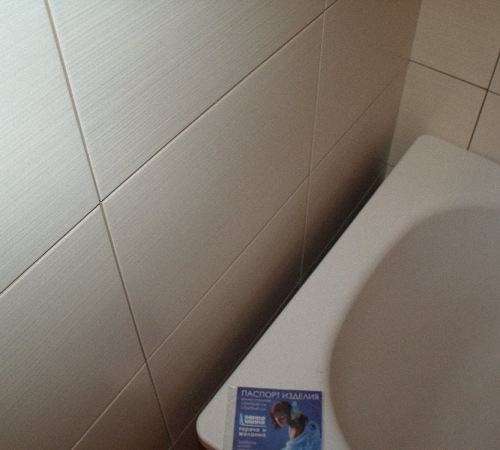
As you know, all this is harmful for:
- weakened and elderly people;
- children;
- allergy sufferers;
- citizens sensitive to the pathogenic environment.
With an excess of moisture, building materials and surface finishes get wet and lose their excellent consumer properties. Damp tile becomes porous, expanded and more brittle, wood swells and deforms, and cracks form on some other materials. Water is known for its ability to penetrate into the smallest crevice, but from there it is poorly removed by natural evaporation. This leads to decay and destruction not only of any viscous medium, but also of rather strong solid building materials.
If mold has started under the bathtub, where water flows through the gap, most likely, it will gradually conquer other space as well. For example, the seams between the tiles or the corners near the bathtub will turn black, and dark spots will appear near the ceiling, and then it will be most difficult to deal with it. If the bathtub is installed after laying the tiles on the walls of the bathroom, then a large gap usually forms between the bathtub and the wall, where water flows when bathing. This defect will somehow have to be eliminated - to close up the gap between the bathroom and the video wall.
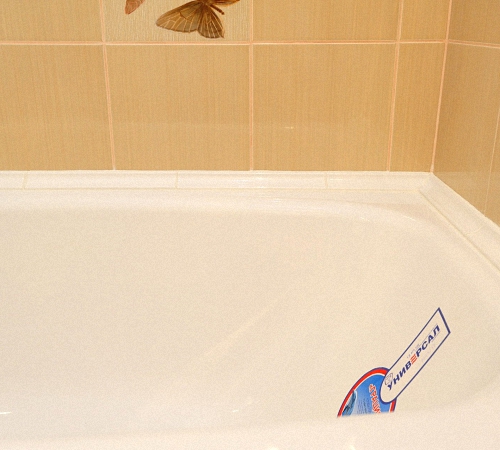
The choice of material to eliminate the gap between the bathroom and the wall
There are several options for how to remove the gaps between the bathroom and the wall, and this depends not only on the width of this gap, but also on the overall finish. There are also minor factors such as:
- tank configuration,
- the presence of ventilation,
- temperature drops,
- overall design.
If the dimensions of the bath approximately coincide with the niche where it should be installed, then experts recommend:
- lay out the floors under the bathroom,
- install the tank,
- lay tiles or other cladding so that the tiles rest on the bathtub,
- additionally process the joint with a special tile skirting board,
- be sure to close up large gaps between the bathroom and the wall of any kind with a border.
Also, the material from which the product is made is taken into account. For example, an acrylic bathtub should not be treated with rough building materials, but even a small gap near the wall will still have to be foamed or filled with silicone. But this is not enough to eliminate the installation defect, since it will deform and sag under the pressure of the acrylic tank. Over time, the tightness of the silicone seal may break. Special sealants are not always advisable. And the bathtub must be additionally attached to the wall so that it does not stand on the same legs or drain pipes.

It is important to securely mount the container using conventional hooks or anchors. It is enough to screw them in at the corners and in the center of the long side of the container for hygiene procedures:
- baths,
- home mini-pool,
- shower tray.
And although all these containers require different methods of sealing, the gap near the wall will have to be eliminated in any case. This is done in different ways, for example, with a special soft tape or a hard border.
The main ways to close the gap in the wall hermetically
You can fill in a deep gap or a small gap between the bathroom and the wall in different ways, using decorative materials, ordinary grout or sealant. It is important that the filler underneath them does not fall out into the gap during work. There are certain difficulties in how to close the gap between the bathroom and the wall with a large hole. The choice of sealing method depends solely on:
- the size of the gap against the wall,
- bath stability,
- decorative properties of the finish and the material to be laid in the seam.
1. You can use a regular plastic profile (corner), which can easily close a small gap or irregularities in the tile masonry at the junction near the bath. It can be fixed with any construction adhesive or assembly silicone. And the joint at the corner and the ends of the plastic profile must be properly cut off, accurately measured according to the dimensions of the container. It is important to cut the corner at 45 °, and sand the edges so that the joining is accurate. Further along the edge of the bath, silicone is applied, which should flow deep into the cracks and harden a little, and only the field of this seam can be closed with a corner. Remove excess silicone by lightly pressing down on the plastic profile. Anything that comes out when pressed is superfluous, it must be carefully cut off with a knife after hardening or wipe off the liquid silicone sealant with a damp cloth.
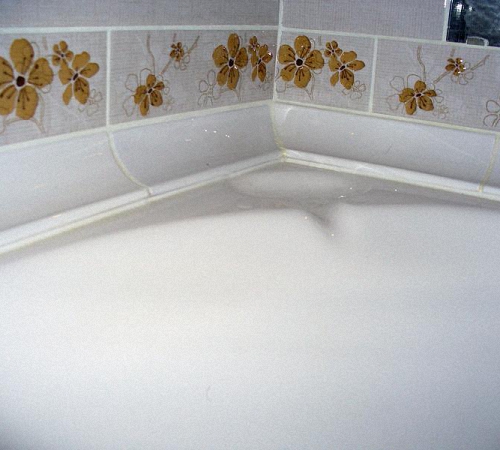
Attention: Whatever solution, glue, foam or sealant you use when sealing the gap between the bathroom and the wall, try to lay them out a little less than necessary, otherwise the seal will turn out to be sloppy. It is better to remove all traces from application before drying, so as not to spoil the surface of the wall and bathtub with the remnants of the adhesive base!
2. Another way of embedding is to use a decorative tile corner or border of small width. In the old fashioned way, they also used narrow strips of ordinary tiles, laid at an angle of 45 ° relative to the bath. But this method is not acceptable with a large gap, or the gap had to be sealed with glazing beads so that the cement mortar would not fall out of the bath.
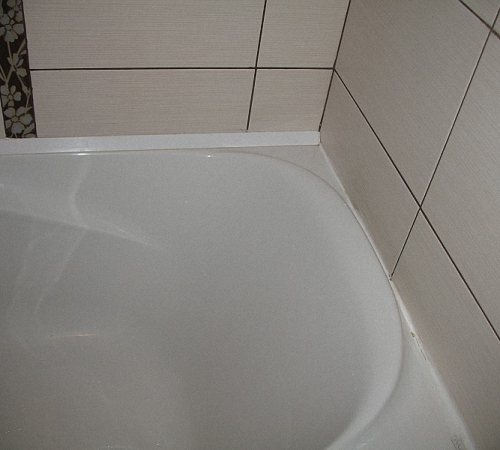
3. Of the modern methods, the simplest method of sealing the gap is a self-adhesive bathroom border tape and a specialized plastic skirting board. It can also be mounted directly on silicone, but with a large gap, this method is also unacceptable. The installation of the corner is associated with a reliable fastening, which requires thorough cleaning and degreasing of both surfaces.
4. Self-adhesive in the form of a border tape - we correctly seal large gaps between the bathroom and the wall. It is sold in any building supermarket in the form of a roll. However, it must be correctly glued to both surfaces so that the seam is even and neat. Experts recommend gluing the roll tape from the corner, first, only on one side of the junction between the wall and the bath. The layer, which must reliably adhere to smooth surfaces, has a protective film, which is carefully removed 15-25 cm each just before dry gluing.
Attention: It is important that the container and wall finishing materials are absolutely dry, otherwise the gluing will have to be repeated, and the roll will already be damaged!
5. A fair question - how to cover up the gaps between the bathroom and the wall, if they are too wide, or when there are openings diverging at an angle that deviate from the right angle at the corner of the bathroom where the container is installed? The above methods do not work here. In some cases, special carpentry skills are required to fill the gap with wood block with a protective impregnation from moisture and mold. From above, the seam has to be concreted, and only then a decorative border should be laid - plastic or tiled. The similarity of wooden formwork at the edges of the wide gap holds the concrete mortar.
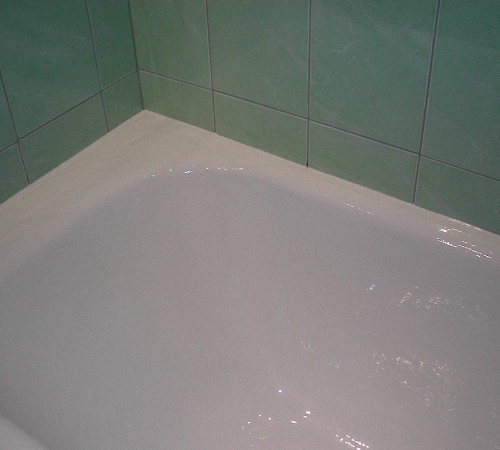
Tip: You can use the listed tips or come up with your own method based on the finishing materials and bathroom design. However, not all materials are suitable for this purpose. For example, a mirror strip laid on a joint at an angle will look original and practical, but over time, moisture destroys the amalgam layer on the back of the glass, resulting in ugly stains. Whatever you decorate the seam, remember the practicality and tightness.
Silicone Sealant Properties
Modern methods of sealing and sealing joints in rooms with high humidity usually involve the use of silicone sealants. It is a synthetic transparent polymer that resembles liquid rubber or dense gel. It is used for various purposes and when interacting with other building materials. It contains various additives that affect its properties:
- density,
- moisture resistance,
- adhesion.

Filling the seam or gap between the bathroom and the tile with a moisture-resistant polymer is the most common method for small crevices or irregularities in the laying of tiles. An unsuccessfully processed gap can always be additionally decorated with a plastic profile or even a foam border for painting, but before it hardens.
There are sealants:
- multicomponent,
- one-component.
According to the chemical composition, the silicone sealants offered for sale are divided into:
- acidic;
- neutral.
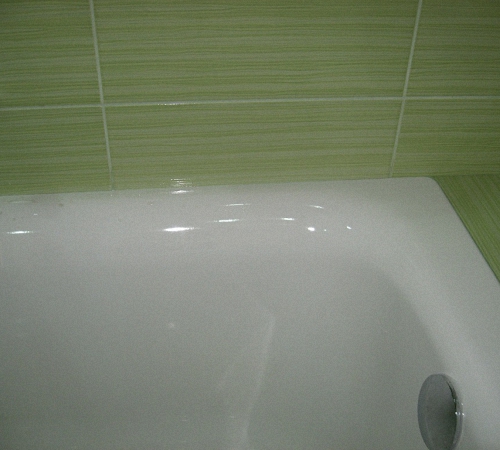
They differ in the method and time of hardening, as it depends on a chemical reaction or under the influence of an open environment. They react differently to temperature extremes, exposure to ultraviolet radiation and humidity. This is why it is important to read the instructions when purchasing silicone sealant. Before using it, it is important to clearly understand:
- the way it is applied,
- hardening time,
- interaction with decorative and finishing materials.
Attention: Acidic sealant is not suitable for metal surfaces, which oxidizes stainless steel or aluminum profiles, which leads to corrosion! Experts recommend using only neutral silicone.
The rest of the sealant has no "drawbacks", it is reliable and easy to use. It dries up completely after 5-12 hours, but it is better to swim in the bathroom no earlier than a day after processing.
However, not everyone knows how to achieve a smooth and aesthetic surface when applied.
Tip: Apply silicone sealant little by little, evenly, gently trimming the top layer on the joint between the tub and the wall with a trowel. In order not to stain the mating surfaces, use masking tape. Remove excess silicone immediately with a spatula, if hardened with a sharp knife. Any accumulations of excess sealant should not be left before hardening, so that you can then cut off, clean them 10-20 minutes after work and treat the adjacent surfaces to remove all traces of application.
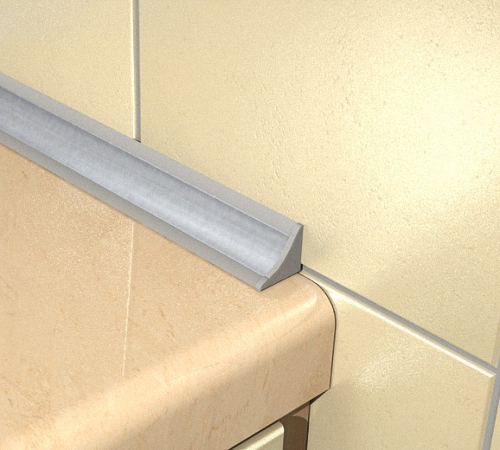
What is important to know when sealing the gap between the bathroom wall
1. It is necessary to thoroughly clean all surfaces to be treated from abrasive particles, debris, mold, rust, calcium deposits from prolonged use of water.
2. It is important to degrease the wall and bath before application and dry it after cleaning. It is also recommended to use white spirit, ethyl alcohol or other volatile solvent for surface treatment.
3. Chemicals used to seal can be harmful to health, so be sure to use a household respirator. Upon completion of the work, be sure to ventilate the room, do not use the bathroom for at least a day, and before taking a shower or bath, be sure to rinse the container well with a jet from a flexible shower.
4. Any material used to seal the joint, including sealant and grout, should not drip or fall into the gap in large quantities. Optimal penetration of the composition beyond the edge of the bath is no more than 1 cm.
5. Make sure that there are no gaps when applying mortar or silicone, otherwise the tightness of the seam will break.
6. All tools for applying grout or sealant should be close at hand so that you do not have to search for them or buy them while the mixture hardens in drifts.

7. Polyurethane foam can also be used as the main material for sealing the gap between the wall and the water tank. Remember that when it hardens, it expands and bursts, adjacent surfaces, and its excess does not look aesthetically pleasing. All excess must be carefully cut off, and the seam must be closed with a decorative border. Places where it went beyond the seam to the bathroom, clean with a rag dipped in a solution of vinegar.
8. Bath curb tape is an excellent option, but it is short-lived, so you should count on 1.5-2 years of its operation. In addition, it contains a fungicide that prevents mold growth. It can be recommended for use over polyurethane foam to close its porous structure.
Attention: When applying decorative finishing materials to the seam, you can also use not only cement mortar and silicone, but also any construction glue, liquid nails, etc. However, the sealing of the gap itself must be perfect!
Tip: If there are problems with mold in the bathroom, be sure to thoroughly clean all surfaces before sealing the seam and treat with a special fungicide solution that prevents its development. Only then can all work on the sealing of the seam begin. Do not think that the mold itself will "evaporate" somewhere after removing the cause of excessive moisture - it is very tenacious and harmful to health!
